Wei Jia
StableToken: A Noise-Robust Semantic Speech Tokenizer for Resilient SpeechLLMs
Sep 26, 2025Abstract:Prevalent semantic speech tokenizers, designed to capture linguistic content, are surprisingly fragile. We find they are not robust to meaning-irrelevant acoustic perturbations; even at high Signal-to-Noise Ratios (SNRs) where speech is perfectly intelligible, their output token sequences can change drastically, increasing the learning burden for downstream LLMs. This instability stems from two flaws: a brittle single-path quantization architecture and a distant training signal indifferent to intermediate token stability. To address this, we introduce StableToken, a tokenizer that achieves stability through a consensus-driven mechanism. Its multi-branch architecture processes audio in parallel, and these representations are merged via a powerful bit-wise voting mechanism to form a single, stable token sequence. StableToken sets a new state-of-the-art in token stability, drastically reducing Unit Edit Distance (UED) under diverse noise conditions. This foundational stability translates directly to downstream benefits, significantly improving the robustness of SpeechLLMs on a variety of tasks.
LatticeWorld: A Multimodal Large Language Model-Empowered Framework for Interactive Complex World Generation
Sep 05, 2025Abstract:Recent research has been increasingly focusing on developing 3D world models that simulate complex real-world scenarios. World models have found broad applications across various domains, including embodied AI, autonomous driving, entertainment, etc. A more realistic simulation with accurate physics will effectively narrow the sim-to-real gap and allow us to gather rich information about the real world conveniently. While traditional manual modeling has enabled the creation of virtual 3D scenes, modern approaches have leveraged advanced machine learning algorithms for 3D world generation, with most recent advances focusing on generative methods that can create virtual worlds based on user instructions. This work explores such a research direction by proposing LatticeWorld, a simple yet effective 3D world generation framework that streamlines the industrial production pipeline of 3D environments. LatticeWorld leverages lightweight LLMs (LLaMA-2-7B) alongside the industry-grade rendering engine (e.g., Unreal Engine 5) to generate a dynamic environment. Our proposed framework accepts textual descriptions and visual instructions as multimodal inputs and creates large-scale 3D interactive worlds with dynamic agents, featuring competitive multi-agent interaction, high-fidelity physics simulation, and real-time rendering. We conduct comprehensive experiments to evaluate LatticeWorld, showing that it achieves superior accuracy in scene layout generation and visual fidelity. Moreover, LatticeWorld achieves over a $90\times$ increase in industrial production efficiency while maintaining high creative quality compared with traditional manual production methods. Our demo video is available at https://youtu.be/8VWZXpERR18
GLM-4.1V-Thinking: Towards Versatile Multimodal Reasoning with Scalable Reinforcement Learning
Jul 02, 2025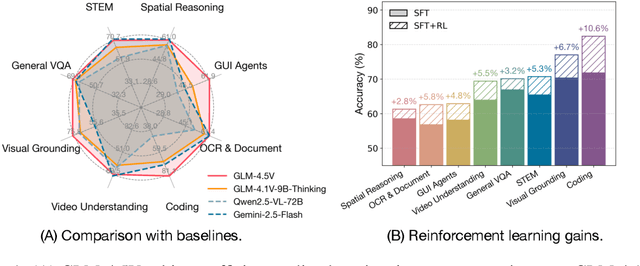
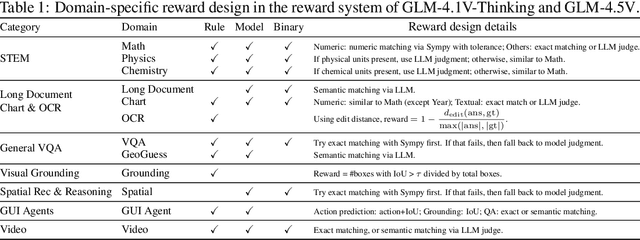
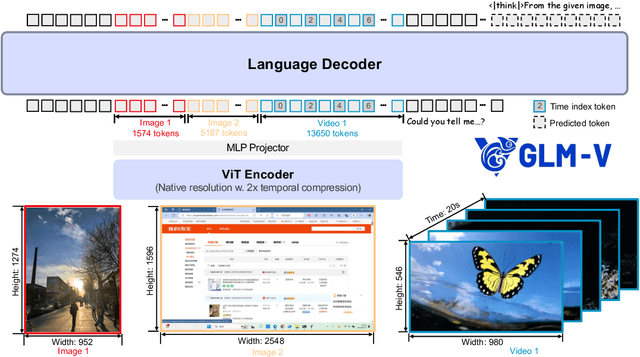

Abstract:We present GLM-4.1V-Thinking, a vision-language model (VLM) designed to advance general-purpose multimodal understanding and reasoning. In this report, we share our key findings in the development of the reasoning-centric training framework. We first develop a capable vision foundation model with significant potential through large-scale pre-training, which arguably sets the upper bound for the final performance. We then propose Reinforcement Learning with Curriculum Sampling (RLCS) to unlock the full potential of the model, leading to comprehensive capability enhancement across a diverse range of tasks, including STEM problem solving, video understanding, content recognition, coding, grounding, GUI-based agents, and long document understanding. We open-source GLM-4.1V-9B-Thinking, which achieves state-of-the-art performance among models of comparable size. In a comprehensive evaluation across 28 public benchmarks, our model outperforms Qwen2.5-VL-7B on nearly all tasks and achieves comparable or even superior performance on 18 benchmarks relative to the significantly larger Qwen2.5-VL-72B. Notably, GLM-4.1V-9B-Thinking also demonstrates competitive or superior performance compared to closed-source models such as GPT-4o on challenging tasks including long document understanding and STEM reasoning, further underscoring its strong capabilities. Code, models and more information are released at https://github.com/THUDM/GLM-4.1V-Thinking.
Seed1.5-VL Technical Report
May 11, 2025Abstract:We present Seed1.5-VL, a vision-language foundation model designed to advance general-purpose multimodal understanding and reasoning. Seed1.5-VL is composed with a 532M-parameter vision encoder and a Mixture-of-Experts (MoE) LLM of 20B active parameters. Despite its relatively compact architecture, it delivers strong performance across a wide spectrum of public VLM benchmarks and internal evaluation suites, achieving the state-of-the-art performance on 38 out of 60 public benchmarks. Moreover, in agent-centric tasks such as GUI control and gameplay, Seed1.5-VL outperforms leading multimodal systems, including OpenAI CUA and Claude 3.7. Beyond visual and video understanding, it also demonstrates strong reasoning abilities, making it particularly effective for multimodal reasoning challenges such as visual puzzles. We believe these capabilities will empower broader applications across diverse tasks. In this report, we mainly provide a comprehensive review of our experiences in building Seed1.5-VL across model design, data construction, and training at various stages, hoping that this report can inspire further research. Seed1.5-VL is now accessible at https://www.volcengine.com/ (Volcano Engine Model ID: doubao-1-5-thinking-vision-pro-250428)
Understanding Stragglers in Large Model Training Using What-if Analysis
May 09, 2025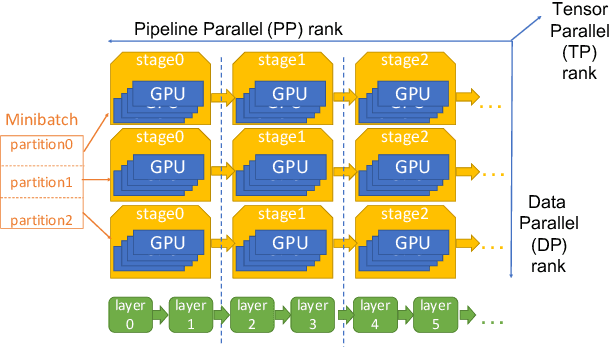

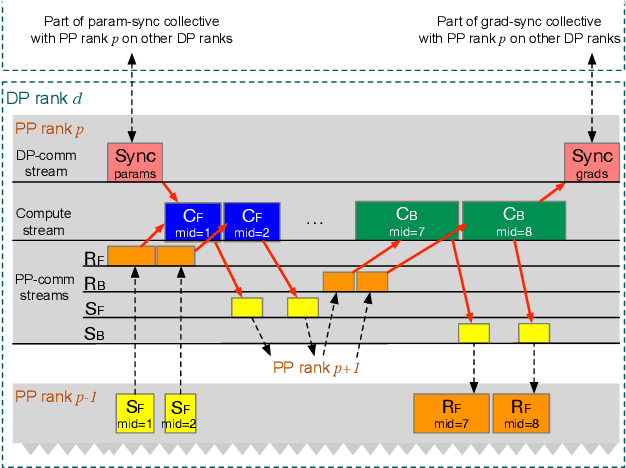
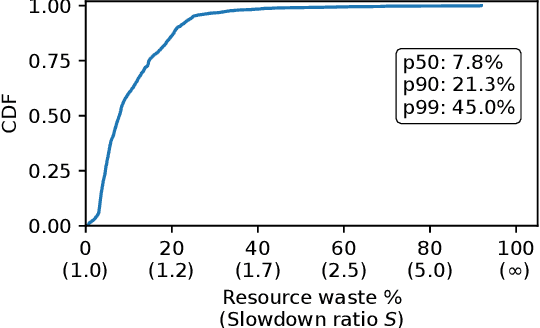
Abstract:Large language model (LLM) training is one of the most demanding distributed computations today, often requiring thousands of GPUs with frequent synchronization across machines. Such a workload pattern makes it susceptible to stragglers, where the training can be stalled by few slow workers. At ByteDance we find stragglers are not trivially always caused by hardware failures, but can arise from multiple complex factors. This work aims to present a comprehensive study on the straggler issues in LLM training, using a five-month trace collected from our ByteDance LLM training cluster. The core methodology is what-if analysis that simulates the scenario without any stragglers and contrasts with the actual case. We use this method to study the following questions: (1) how often do stragglers affect training jobs, and what effect do they have on job performance; (2) do stragglers exhibit temporal or spatial patterns; and (3) what are the potential root causes for stragglers?
OVERLORD: Ultimate Scaling of DataLoader for Multi-Source Large Foundation Model Training
Apr 14, 2025Abstract:Modern frameworks for training large foundation models (LFMs) employ data loaders in a data parallel paradigm. While this design offers implementation simplicity, it introduces two fundamental challenges. First, due to the quadratic computational complexity of the attention operator, the non-uniform sample distribution over data-parallel ranks leads to a significant workload imbalance among loaders, which degrades the training efficiency. This paradigm also impedes the implementation of data mixing algorithms (e.g., curriculum learning) over different datasets. Second, to acquire a broad range of capability, LFMs training ingests data from diverse sources, each with distinct file access states. Colocating massive datasets within loader instances can easily exceed local pod memory capacity. Additionally, heavy sources with higher transformation latency require larger worker pools, further exacerbating memory consumption. We present OVERLORD, an industrial-grade distributed data loading architecture with three innovations: (1) A centralized and declarative data plane, which facilitates elastic data orchestration strategy, such as long-short context, multimodal, and curriculum learning; (2) Disaggregated multisource preprocessing through role-specific actors, i.e., Source Loaders and Data Constructors, leveraging autoscaling for Source Loaders towards heterogeneous and evolving source preprocessing cost; (3) Shadow Loaders with differential checkpointing for uninterrupted fault recovery. Deployed on production clusters scaling to multi-thousand GPU, OVERLORD achieves: (1) 4.5x end-to-end training throughput improvement, (2) a minimum 3.6x reduction in CPU memory usage, with further improvements to be added in later experiments.
PVTree: Realistic and Controllable Palm Vein Generation for Recognition Tasks
Mar 04, 2025Abstract:Palm vein recognition is an emerging biometric technology that offers enhanced security and privacy. However, acquiring sufficient palm vein data for training deep learning-based recognition models is challenging due to the high costs of data collection and privacy protection constraints. This has led to a growing interest in generating pseudo-palm vein data using generative models. Existing methods, however, often produce unrealistic palm vein patterns or struggle with controlling identity and style attributes. To address these issues, we propose a novel palm vein generation framework named PVTree. First, the palm vein identity is defined by a complex and authentic 3D palm vascular tree, created using an improved Constrained Constructive Optimization (CCO) algorithm. Second, palm vein patterns of the same identity are generated by projecting the same 3D vascular tree into 2D images from different views and converting them into realistic images using a generative model. As a result, PVTree satisfies the need for both identity consistency and intra-class diversity. Extensive experiments conducted on several publicly available datasets demonstrate that our proposed palm vein generation method surpasses existing methods and achieves a higher TAR@FAR=1e-4 under the 1:1 Open-set protocol. To the best of our knowledge, this is the first time that the performance of a recognition model trained on synthetic palm vein data exceeds that of the recognition model trained on real data, which indicates that palm vein image generation research has a promising future.
PoAct: Policy and Action Dual-Control Agent for Generalized Applications
Jan 13, 2025



Abstract:Based on their superior comprehension and reasoning capabilities, Large Language Model (LLM) driven agent frameworks have achieved significant success in numerous complex reasoning tasks. ReAct-like agents can solve various intricate problems step-by-step through progressive planning and tool calls, iteratively optimizing new steps based on environmental feedback. However, as the planning capabilities of LLMs improve, the actions invoked by tool calls in ReAct-like frameworks often misalign with complex planning and challenging data organization. Code Action addresses these issues while also introducing the challenges of a more complex action space and more difficult action organization. To leverage Code Action and tackle the challenges of its complexity, this paper proposes Policy and Action Dual-Control Agent (PoAct) for generalized applications. The aim is to achieve higher-quality code actions and more accurate reasoning paths by dynamically switching reasoning policies and modifying the action space. Experimental results on the Agent Benchmark for both legal and generic scenarios demonstrate the superior reasoning capabilities and reduced token consumption of our approach in complex tasks. On the LegalAgentBench, our method shows a 20 percent improvement over the baseline while requiring fewer tokens. We conducted experiments and analyses on the GPT-4o and GLM-4 series models, demonstrating the significant potential and scalability of our approach to solve complex problems.
Deep Learning in Palmprint Recognition-A Comprehensive Survey
Jan 02, 2025



Abstract:Palmprint recognition has emerged as a prominent biometric technology, widely applied in diverse scenarios. Traditional handcrafted methods for palmprint recognition often fall short in representation capability, as they heavily depend on researchers' prior knowledge. Deep learning (DL) has been introduced to address this limitation, leveraging its remarkable successes across various domains. While existing surveys focus narrowly on specific tasks within palmprint recognition-often grounded in traditional methodologies-there remains a significant gap in comprehensive research exploring DL-based approaches across all facets of palmprint recognition. This paper bridges that gap by thoroughly reviewing recent advancements in DL-powered palmprint recognition. The paper systematically examines progress across key tasks, including region-of-interest segmentation, feature extraction, and security/privacy-oriented challenges. Beyond highlighting these advancements, the paper identifies current challenges and uncovers promising opportunities for future research. By consolidating state-of-the-art progress, this review serves as a valuable resource for researchers, enabling them to stay abreast of cutting-edge technologies and drive innovation in palmprint recognition.
LegalAgentBench: Evaluating LLM Agents in Legal Domain
Dec 23, 2024Abstract:With the increasing intelligence and autonomy of LLM agents, their potential applications in the legal domain are becoming increasingly apparent. However, existing general-domain benchmarks cannot fully capture the complexity and subtle nuances of real-world judicial cognition and decision-making. Therefore, we propose LegalAgentBench, a comprehensive benchmark specifically designed to evaluate LLM Agents in the Chinese legal domain. LegalAgentBench includes 17 corpora from real-world legal scenarios and provides 37 tools for interacting with external knowledge. We designed a scalable task construction framework and carefully annotated 300 tasks. These tasks span various types, including multi-hop reasoning and writing, and range across different difficulty levels, effectively reflecting the complexity of real-world legal scenarios. Moreover, beyond evaluating final success, LegalAgentBench incorporates keyword analysis during intermediate processes to calculate progress rates, enabling more fine-grained evaluation. We evaluated eight popular LLMs, highlighting the strengths, limitations, and potential areas for improvement of existing models and methods. LegalAgentBench sets a new benchmark for the practical application of LLMs in the legal domain, with its code and data available at \url{https://github.com/CSHaitao/LegalAgentBench}.
 Add to Chrome
Add to Chrome Add to Firefox
Add to Firefox Add to Edge
Add to Edge